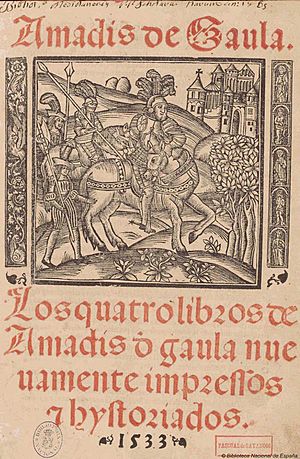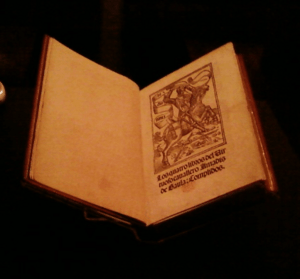Amadís de Gaula facts for kids
Quick facts for kids 
Spanish edition of Amadis of Gaula (1533)
|
|
| Author | Garci Rodríguez de Montalvo |
|---|---|
| Original title | Amadís de Gaula |
| Country | Iberian Peninsula (Portugal and Spain) |
| Language | Early Modern Spanish |
| Genre | Chivalric romance |
|
Publication date
|
Before 1508 |
|
Published in English
|
1590 |
| Followed by | Las sergas de Esplandián |
Amadís de Gaula (which means Amadis of Gaul in English) is a very famous story from the Iberian Peninsula (where Portugal and Spain are). It's a type of story called a chivalric romance. These stories were very popular in the 1500s. The first known version of Amadís was written a long time ago, around the early 1300s.
The oldest complete book we still have was printed in Zaragoza, Spain, in 1508. This version was put together by Garci Rodríguez de Montalvo. He said he fixed up the first three parts and wrote the fourth part himself. People think there might have been even older printed versions, but they are now lost. The story is written in Castilian Spanish. Its beginnings are a bit of a mystery. It comes from the old King Arthur type of stories.
Some people believe a Portuguese writer named Vasco de Lobeira wrote an earlier version. Others think it was João de Lobeira. There are even ideas that Henry of Castile might have written it. No matter who wrote the very first parts, Montalvo's version is the one that became famous. He even added a follow-up story called Las sergas de Esplandián. He pretended he found this story in a hidden chest!
Amadís de Gaula was the favorite book of Don Quixote, a famous character in a novel by Miguel de Cervantes.
Contents
What is Amadís de Gaula About?
Meet the Main Characters
The story begins with a secret love story between King Perión of Gaula and Elisena of England. They have a son named Amadís. Gaula is a made-up kingdom, often thought to be in Brittany.
Amadís's Adventures
Amadís is left alone as a baby on a raft in England. A kind knight named Gandales finds him and raises him in Scotland. As Amadís grows up, he goes on many amazing adventures to find out where he came from.
He faces challenges from a bad wizard named Arcaláus. But a magical priestess, Urganda la Desconocida (Urganda the Unknown), protects him. She has special powers and can see the future.
Love and Challenges
Amadís becomes a knight, thanks to his father, King Perión. He proves his bravery by passing tests on an enchanted island called Ínsola Firme. One big test is going through the Arch of Faithful Lovers.
Amadís is very loyal to his childhood sweetheart, Oriana. She is the future queen of Great Britain. But one day, Oriana gets jealous of another princess. She sends Amadís a letter to tell him off.
This makes Amadís so sad that he changes his name to Beltenebros. He goes to a lonely place called Peña Pobre (Poor Peak) and acts like he's lost his mind for a long time.
Reunion and Family
Amadís only gets better when Oriana sends her maid to bring him back. He then helps Oriana's father, King Lisuarte, fight off invaders. Soon after, Amadís and Oriana have a secret meeting. Their son, Esplandián, is born from this meeting.
In the original story, it was said that Esplandián might kill his father for this. But Montalvo changed the ending so they could make peace.
Oriana and Amadís wait many years to get married. This is because Amadís and Oriana's father, Lisuarte, don't get along. Amadís leaves Britain for about 10 years. During this time, he pretends to be "The Knight of the Green Sword." He travels far, even to Constantinople. There, he meets a young princess named Leonorina, who later marries his son, Esplandián.
Unlike many heroes of his time, Amadís was handsome and sensitive. He would even cry if his lady turned him down. But he was also an amazing fighter and almost impossible to beat in battle.
Why is Amadís de Gaula Important?
A Hero for His Time
Amadís was called Amadís sin tiempo (Amadis without Time) by his mother. This was because she had to leave him as a baby. He became the most famous hero of chivalric romance in the Iberian Peninsula.
His adventures filled four books and were incredibly popular. People in the 1500s loved reading about him. The books showed a perfect and simple idea of what a knight should be. There were many princesses, ladies, and kings, and knights always helped damsels in distress.
Writing Style
The way the book is written is quite modern for its time. It mostly describes the action, but it doesn't have a lot of talking or show what characters are thinking.
The writing style was generally liked. It used some fancy language, like putting the verb at the end of a sentence. This made it sound like the serious stories of the 1400s.
However, when Garci Rodríguez de Montalvo added the fourth book, the style changed. It became more serious and less exciting. The first three books felt more like the exciting knight stories from the 1200s. The original parts of Amadís were lively and focused on war and love, with short, elegant conversations.
Amadís of Gaula is often mentioned in the funny classic book Don Quixote. Don Quixote looks up to Amadís and tries to be just like him.
Influence on History
Historically, Amadís was very important to the Spanish conquistadors. These were the explorers who went to the Americas. For example, Bernal Díaz del Castillo was amazed by the city of Tenochtitlan (now Mexico City). He said it reminded him of the wonders in Amadís. Even the name California comes directly from this book!
The famous British writer C.S. Lewis also said that Amadís was one of his favorite books. He especially loved the character Oriana.
Where Did Amadís Come From?
Montalvo's Version
The only full version of Amadís de Gaula that we know of is by Garci Rodríguez de Montalvo. The oldest book we have is from 1508. But experts believe there were earlier versions. Since Montalvo's text is in Castilian Spanish, it was likely written in that language.
Old Fragments
Some old pieces of the book from the 1400s have been found. They were used to bind other books. These pieces show that Montalvo might have actually made the first three books shorter, not longer, as people used to think.
Early Mentions
Amadís was mentioned in another book around 1350. This is the oldest known mention of the story.
Other Amadís Stories
Amadís of Gaul was so popular that many other books were written about him and his family. These were called sequels. Montalvo himself wrote Las sergas de Esplandián (Book V). Other writers added even more books.
Miguel de Cervantes wrote Don Quixote to make fun of these knight stories. But he and his character Don Quixote still thought the original Amadís was a great book.
Spanish Sequels
Here are some of the Spanish books in the series:
- Books I–IV: Before 1508 (Garci Rodríguez de Montalvo): Amadís de Gaula
- Book V: 1510 (Garci Rodríguez de Montalvo): Esplandián (Amadís's son)
- Book VII: 1514 (Feliciano de Silva): Lisuarte de Grecia
- Book IX: 1530 (Feliciano de Silva): Amadís de Grecia (Amadis of Greece)
- Book X: 1532 (Feliciano de Silva): Florisel de Niquea
- Book XI: 1535 & 1551 (Feliciano de Silva): Rogel de Grecia
- Book XII: 1546 (Pedro de Luján): Silves de la Selva
Translations and Other Series
Amadís was translated into many languages, like French, German, and Italian. The French version was very popular and had 24 books!
In Portugal, the Amadís stories also led to other adventure series, such as:
- Palmeirim de Inglaterra (Palmeirim of England) by Francisco de Morais Cabral: around 1544
- Dom Duardos by Diogo Fernandes
- Dom Clarisel de Bretanha by Gonçalves Lobato
- Crónica do Imperador Clarimundo (Chronicle of Emperor Clarimund) by João de Barros
Operas Based on Amadís
The story of Amadís was so inspiring that it was even turned into operas!
- Amadis (1684) by Jean-Baptiste Lully
- Amadis de Grèce (1699) by André Cardinal Destouches
- Amadigi di Gaula (1715) by George Frideric Handel
- Amadis de Gaule (1771) by Jean-Benjamin de La Borde and Pierre Montan Berton
- Amadis de Gaule (1779) by Johann Christian Bach
- Amadis (1922) by Jules Massenet
See also
 In Spanish: Amadís de Gaula para niños
In Spanish: Amadís de Gaula para niños



